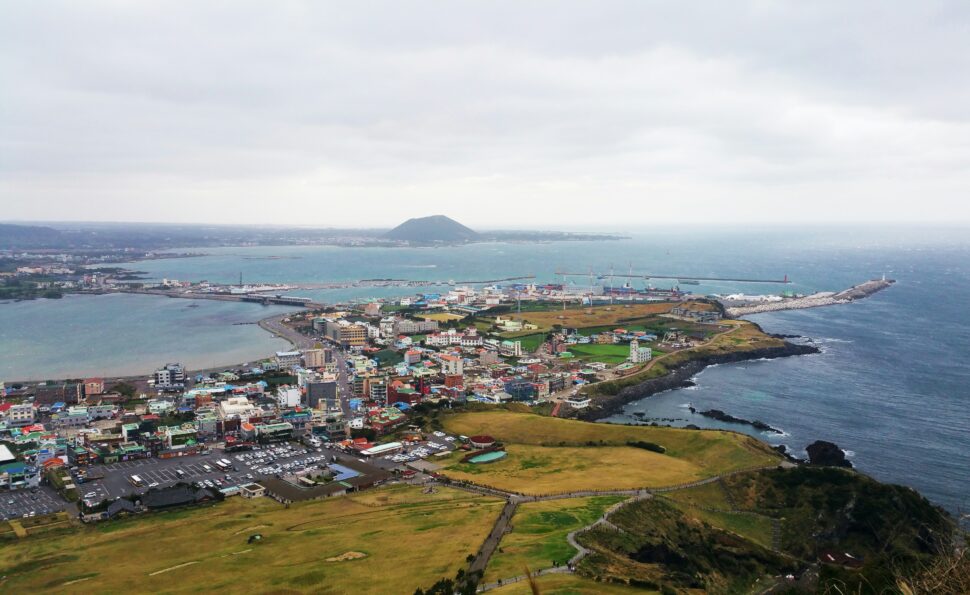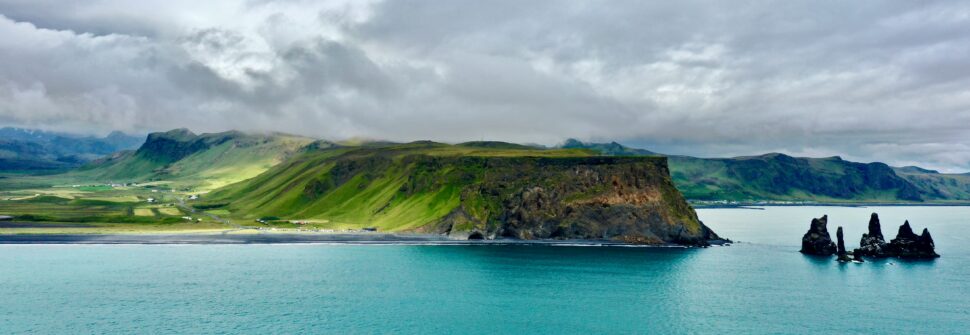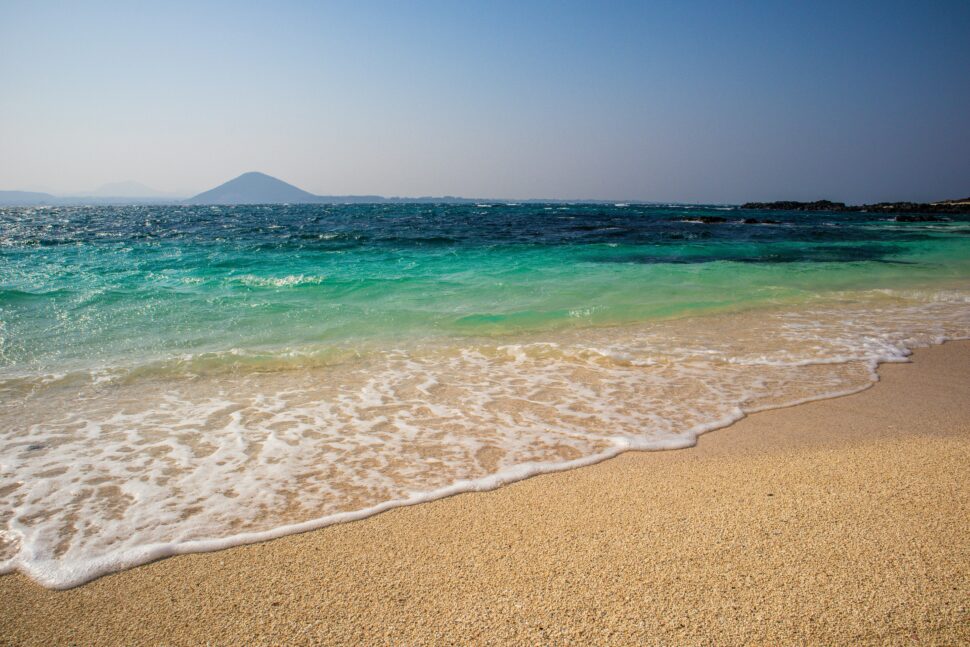South Korea’s Jeju Island, often called the “Hawaii of South Korea,” is a must-visit destination for travelers seeking island life. When the tropical mood hits and travelers need a destination with a year-round climate, Jeju does not disappoint. The island is dotted with resorts and accommodations for both budget-friendly and luxury stays. This island itinerary highlights the top 4 places to visit on Jeju Island. We’ve put together itineraries for both short getaways and extended vacations to the South Korean island.
Top 4 Places to Visit on South Korea’s Jeju Island

Seongsan Ilchulbong (Sunrise Peak)
Seongsan Ilchulbong, also known as Sunrise Peak, is one of Jeju Island’s most iconic natural landmarks. This UNESCO World Heritage site is a tuff cone crater formed by hydrovolcanic eruptions over 5,000 years ago. Over time, the eruption built up layers of volcanic ash and rock, marking a bowl-shaped crater at the peak.
The peak stands at 182 meters (597 feet) high and is part of the Jeju Volcanic Island and Lava Tubes. For the best experience, plan your visit early in the morning to catch the sunrise. Witness the dazzling colors against the crater’s rugged landscape for those Instagram-worthy shots, a photographer’s dream.
Things to Do:
Hiking to the Peak: The hike is moderately easy and takes about 20-30 minutes. As you ascend, you’ll be rewarded with panoramic views of the surrounding ocean and countryside.
Explore the Seaside Village: The nearby village offers local seafood dishes and traditional markets where you can savor fresh Jeju specialties like grilled mackerel and abalone porridge.
Photography: Capture the sunrise or the stunning views of the crater against the vast blue ocean.
Travel Tip: Wear comfortable hiking shoes and bring a light jacket, as the peak can get windy.

Jeju Loveland
Jeju Loveland is a unique outdoor sculpture park dedicated to love and sensuality. This one-of-a-kind adult-themed park is one of Jeju Island’s most quirky and memorable attractions. Opened in 2004, it features over 140 erotic sculptures created by graduates of Hongik University, one of Korea’s top art schools. The park was designed to explore themes of love, sexuality, and sensuality openly and artistically. Loveland is open year-round. Visit during the daytime for better lighting for photography and a more comfortable experience.
Things to Do:
Explore the Sculptures: The park is filled with imaginative sculptures that spark curiosity and laughter. It’s a great spot to unwind and enjoy the creative atmosphere.
Gift Shop and Café: You can buy Jeju-themed souvenirs or relax at the park’s café with local desserts and coffee.
Art and Culture Exhibitions: Loveland often hosts temporary art exhibitions that complement the park’s bold theme.
Travel Tip: The park is for adults only (18+), so plan accordingly if you’re traveling with family.

Jeju Folk Village Museum
The Jeju Folk Village Museum is an immersive experience of traditional Jeju life during the late Joseon Dynasty (19th century). This open-air museum allows visitors to explore historically accurate reconstructions of Jeju’s past. Located in Seogwipo, the museum spans over 40 acres and features over 100 authentic, restored buildings, including thatched-roof houses, government offices, schools, blacksmith workshops, and more.
The Jeju Folk Village Museum is open throughout the year, but visiting during the spring or fall ensures pleasant weather for comfortable exploration. For scuba divers, the museum celebrates Jeju’s famous female divers, who have harvested seafood without oxygen tanks for centuries.
Things to Do:
Traditional Houses: Walk through well-preserved thatched-roof houses, stone walls, and ancient tools that showcase Jeju’s rural life.
Cultural Performances: The museum hosts traditional music, dance, and folk performances, offering a lively glimpse into Jeju’s cultural past.
Try Local Foods: Don’t miss trying Jeju specialties like black pork barbecue, hallabong (Jeju oranges), and Jeju tea at the village’s eateries.
Travel Tip: Allocate at least 2-3 hours to explore the village thoroughly and attend a cultural performance.

Jungmun Saekdal Beach
Jungmun Saekdal Beach is one of Jeju Island’s beautiful beaches, known for its stunning multicolored sand. The name “Saekdal” comes from the sand’s mix of black, white, red, and gray grains, which creates its distinctive color. Framed by rugged cliffs, lush greenery, and turquoise waters, this picturesque getaway is a blend of natural beauty and modern facilities. For those looking for relaxation and adventure, beach lovers and sun seekers, this place is a must-visit destination.
Summer (June to August) is the best time for beach activities, but the beach’s beauty is captivating year-round. Admission is free. Take things slow!
Things to Do:
Swimming and Sunbathing: The beach offers clear waters and a well-maintained sandy shoreline—ideal for swimming or lounging under the sun.
Water Sports: Try windsurfing, kayaking, or jet-skiing for an adrenaline rush.
Explore the Nearby Jungmun Tourist Complex: The area is home to museums, restaurants, and botanical gardens, providing plenty of activities beyond the beach.
Beachfront Dining: Enjoy fresh seafood at beachside restaurants while watching the sunset.
Travel Tip: If you’re visiting in the summer, plan your beach visit early in the morning or late afternoon to avoid crowds.
Tips and Recommendations for Your Jeju Island Itinerary
Jeju Island offers an array of attractions, so many we can’t mention them all in one itinerary! From natural wonders to cultural deep dives, these 4 places to visit on South Korea’s Jeju Island are just the beginning. Here’s how to make the most of your itinerary:
1. Transportation:
Jeju Island is best explored by renting a car, for the flexibility and access to more remote attractions. Alternatively, taxis and local buses are convenient and affordable.
2. Accommodation:
From luxury resorts in Jungmun to charming guesthouses near Seongsan Ilchulbong, Jeju offers accommodation options for all budgets. Book in advance, especially during peak travel seasons.
3. Local Cuisine:
There’s a great food and café scene on Jeju Island. Try black pork, fresh seafood, hallabong oranges, and tangerine-flavored treats. Make sure to check out local restaurants and food markets.
4. Packing Essentials:
Jeju’s weather can be unpredictable, so pack layers, comfortable walking shoes, sunscreen, and rain gear, especially if you plan to hike or visit outdoor sites.
5. Travel Budget Tips:
For budget-conscious travelers, Jeju offers affordable accommodations, public transportation, and plenty of free or low-cost attractions like waterfalls and hiking trails. Plan your itinerary in advance to avoid last-minute expenses.
How to Make the Most of Your Adventure to South Korea’s Jeju Island
Jeju Island is a treasure trove of natural beauty, cultural richness, and unique experiences. Whether hiking up Sunrise Peak, exploring the quirky Jeju Loveland park, immersing yourself in local culture at the Folk Village, or relaxing on Jungmun Saekdal Beach, Jeju promises an unforgettable adventure. Consider these 4 places to visit as a baseline for your Jeju itinerary so you can get the best experience this South Korean island has to offer.
Frequently Asked Questions (FAQ)
Q: What’s the best time of year to visit Jeju Island?
A: The best time to visit Jeju Island is during spring (April to June) or fall (September to November), when the weather is mild, the skies are clear, and the island’s natural beauty—like cherry blossoms or autumn foliage—is at its peak. These seasons also tend to have fewer tourists compared to summer.
Q: How many days should I spend in Jeju Island?
A: A 3 to 5-day trip is ideal for Jeju Island. This allows enough time to explore major attractions like Hallasan Mountain, the Manjanggul Lava Tube, and the island’s beautiful beaches and waterfalls, while still leaving space for cultural sites and local food experiences.
Q: Is Jeju Island safe for tourists?
A: Yes, Jeju Island is considered very safe for tourists. It has a low crime rate, friendly locals, and a laid-back atmosphere. As with any travel destination, it’s wise to stay aware of your surroundings and keep valuables secure, especially in crowded areas.
Q: What type of public transportation can I use for Jeju Island?
A: Jeju Island has a reliable bus network that connects major tourist areas, but service may be infrequent in rural regions. Renting a car is the most convenient option for exploring the island at your own pace, especially if you’re planning to visit more remote natural attractions. Taxis and tour buses are also available.





